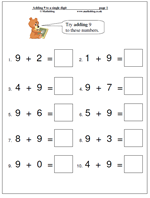 Here are two maths worksheets of practice at adding 9 to a single digit. The obvious method to do this is to add ten and then take away one. However, this method is only efficient if ten is added mentally and not counted on. (Otherwise you might just as well count on 9!) Once again, the aim is for children to become quick and efficient in their heads so that answers are given just as quickly as if they were asked their name.
Here are two maths worksheets of practice at adding 9 to a single digit. The obvious method to do this is to add ten and then take away one. However, this method is only efficient if ten is added mentally and not counted on. (Otherwise you might just as well count on 9!) Once again, the aim is for children to become quick and efficient in their heads so that answers are given just as quickly as if they were asked their name.
Learning tables: 2, 3, 5 and 10 times tables practice
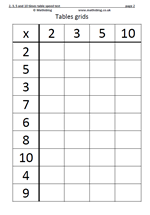 On this maths worksheet is a tables grid for the 2x, 3x, 5x and 10x table.
On this maths worksheet is a tables grid for the 2x, 3x, 5x and 10x table.
The grid is filled in by taking the numbers across the top with the numbers down the side as shown below.
There are many different approaches to this type of problem. Some children fill in the answers in strict order, others go through and complete the ones they know off by heart, and then try to work the rest out.
It is a good idea to set a time limit to these to encourage learning them off by heart.
Year 3 Maths worksheet: What sign to use?
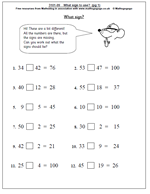 Free maths worksheet from mathsblog.co.uk
Free maths worksheet from mathsblog.co.uk
Here is a page with a difference for year 3 children. All the numbers, both questions and answers are supplied, but the signs are missing. Just pop the signs in to make the number sentences correct.
This will show whether a child has a good sense of number for the four rules. It might well not be necessary to work out the answer, just eliminate possibilities.
Use a calculator to check whether the correct signs have been inserted.
Free maths worksheet: begin to add decimals
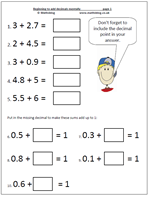 Free maths worksheet from mathsblog.co.uk
Free maths worksheet from mathsblog.co.uk
When it comes to decimals children can become very confused, so here is a nice starter for adding a decimal.
The key to success is to make sure that the units are added to the units, so that 3.4 + 5 is 8.4, not 3.9 and always remember the decimal point in the answer.
Maths worksheet: dividing by 1 and 10
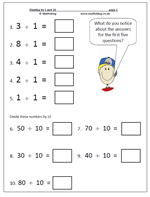 Division is one of the big problem areas in maths, partly because success relies on a good knowledge and understanding of basic number.
Division is one of the big problem areas in maths, partly because success relies on a good knowledge and understanding of basic number.
There are two important ideas about division on this maths worksheet. Firstly, when a number is divided by 1 it stays the same. Fairly obvious to us, but for young children they need to understand division in two ways:
a. understand division as grouping or repeated subtraction. For example: 20 divided by four can be thought of as ‘how many 4s make 20?
8 divided by 1 can be thought of as ‘how many 1s make 8?’
b. understand division as sharing. For example: share 20 sweets between 4 people.
8 divided by 1 can be thought of as sharing 8 between one person ie they get it all!
The second part of this worksheet looks at dividing by 10. Now it has been stressed before that when multiplying by ten we must not say ‘just add a nought’. In the same way when dividing by ten don’t say ‘take away the nought’ because later there will not be any noughts in the questions!
Maths vocabulary for year 2: time
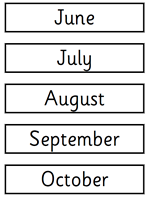 We continue to list the recommended vocabulary in year 2, this section dealing with Time.
We continue to list the recommended vocabulary in year 2, this section dealing with Time.
Words to do with Time include the months of the year:
January February
March April
May June
July August
September October
November December
Plus some more general time words:
minute second
quarter to quarter past
digital analogue
clock watch timer
Remember: children are expected to be acquainted with these words, but not necessarily to be able to spell them.
(Taken from Mathematical Vocabulary Book DfEE)
ContactPoint: Details of all children
Well I like numbers, as you might guess, but did you know that your children, and everyone else’s are going to feature on a new database and each child will be prescribed a unique number! Yes, contact details of every child under 18 is going to go on a huge database, which itself will be accessible to over 390 000 staff. Children’s Minister, Baroness Morgan states that parents would not be allowed to remove their children from the list.
Why, you might ask, is this database being created?
It is thought that the database will improve information sharing between professionals working with children and was created as a result of the death of 8-year old Victoria Climbie.
What information is being collected:
Name
Address
Parents’ contact details
Date of birth
School
Doctor
and each child is given a unique identifying number. Perhaps more worrying is that additional information may be added by the agencies.
Who will be able to see the information? Local authority staff, police, health services and children’s charities to start with. Given our record for keeping databases safe, we can presume that access will be leaked. Is this the best way to spend our money safeguarding children?
This has been planned for 8 years and training is beginning for local authority staff in the near future.
Free Y5 maths worksheet: identify shapes using a binary tree
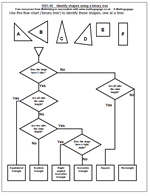 Free maths worksheet from mathsblog and mathsgogogo.co.uk
Free maths worksheet from mathsblog and mathsgogogo.co.uk
Here is a way of identifying shapes that you do not often see in worksheets, but is considered important in the maths curriculum. It is known as identifying shapes by using a binary tree.
A binary tree leads you through a series of questions, which can only be answered yes or no, each question question narrows down the number of possible correct answers, until there is only one left. Binary trees are often used in science but they can also be used in maths.
Free maths worksheet: adding 8 to a single digit
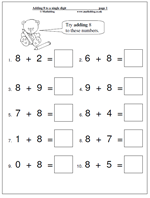 Free maths worksheet from mathsblog.co.uk
Free maths worksheet from mathsblog.co.uk
Here are two straightforward sets of questions which deal with adding 8 to a single digit. Eventually children should know, off by heart, all the answers to these questions, but that takes a lot of time and practice. Confidence can be gained by learning some of them; eg knowing that 8 + 2 makes 10 can lead on to knowing that 8 + 3 makes 11.
Until they have been learnt most children will need to count on, perhaps using fingers or practical apparatus such as cubes to work the answers out.
News: Home schooling
I know that quite a few of the users of the site are home educators so the latest news from the government will interest them. Children’s Minister, Baroness Delyth Morgan, has announced that local authorities need to ensure that those children who do not attend school are taught properly at home.
“Parents are able, quite rightly, to choose whether they want to educate children at home, and a very small number do. I’m sure, the vast majority do a good job,” said Baroness Morgan.
“However, there are concerns that some children are not receiving the education they need. And in some extreme cases, home education could be used as a cover for abuse.”
Surprisingly there is no official figure for the number of children who are taught at home, but estimates suggest around 50 000. There are many reasons for children not attending school, ranging from potential bullying, religion or just a feeling that children can be much better educated at home. In today’s society there are plenty of easily available resources, making it much easier to educate at home and to provide a rich learning environment and I wish all home educators the very best.